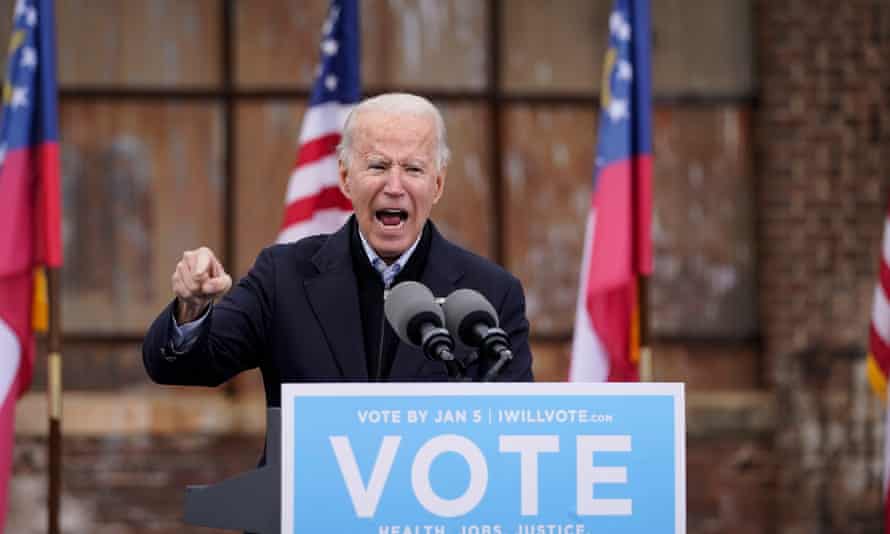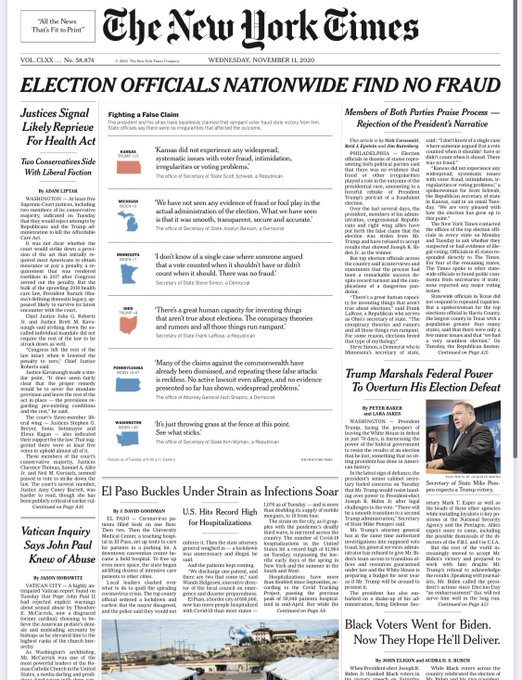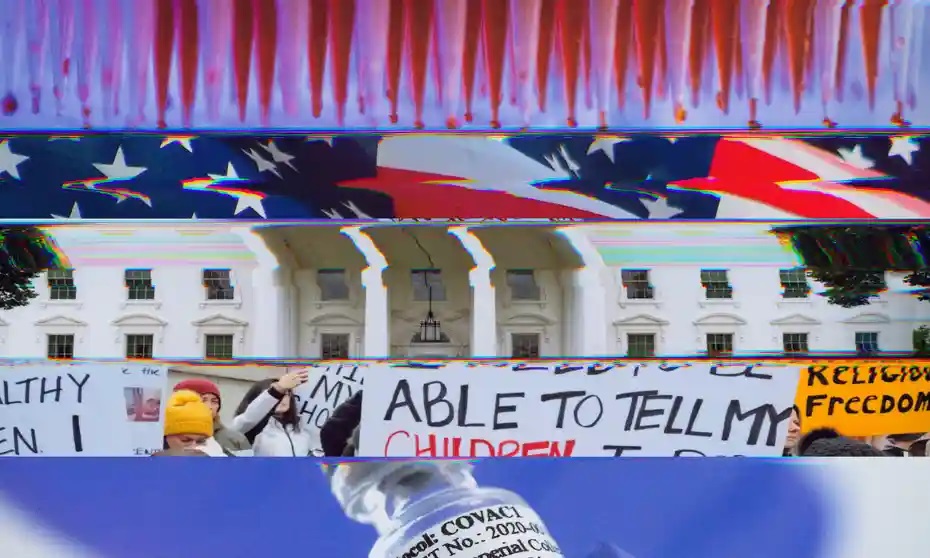Facts won’t fix this: experts on how to fight America’s disinformation crisis
‘What does it look like if we don’t have a shared sense of reality?’ Illustration: Nico Krijno/The Guardian
Trump’s false claims about the election and coronavirus are taking a dangerous toll. Can the divide be healed?
At the beginning of 2021,millions of Americans appear to disagree about one of the most basic facts of their democracy: that Joe Biden won the 2020 presidential election.
The consequences of Donald Trump’s repeated, baseless claimsof voter fraud will come in several waves, researchers who study disinformation say, even if Trump ultimately hands over power and leaves the White House. And there is no quick or easy way to fix this crisis, they warn. Because when it comes to dealing with disinformation, simply repeating the facts doesn’t do much to change anyone’s mind.
In the short term, Trump’s false claims about election fraud have weakened Biden’s ability to address the coronavirus pandemic. “If only 20% of the population is like, ‘You’re not my president, I’m going to double down on my mask resistance,’ or ‘I’m going to continue to have parties over the holidays,’ that means we are going to be even less likely to bring this thing under control,” said Whitney Phillips, a professor of communications at Syracuse University.‘Don’t fuel the fire’: disinformation experts on how Biden should deal with Trump’s election liesRead more
Over the longer term, the president’sfalsehoods may also undermine Biden’s overall governing capability, just as the racist “birther” conspiracy theory, another false claim spread by Trump, helped fuel political resistance to Barack Obama’s presidency. And the damage to Americans’ basic trust in their democracy may have effects far beyond electoral politics.
“What does it look like if we don’t have a shared sense of reality?” said Claire Wardle, the executive director of First Draft, a group that researches and combats disinformation. “We’ve seen more conspiracy theories moving mainstream. There’s an increasing number of people who do not believe in the critical infrastructure of a society. Where does that end?”
How we got here
America’s current disinformation crisis is the culmination of more than two decades of pollution of the country’s information ecosystem, Wardle said. The spread of disinformation on social media is one part of that story, but so is the rise of alternative rightwing media outlets, the lack of investment in public media, the demise of local news outlets, and the replacement of shuttered local newspapers with hyper-partisan online outlets.Advertisement
This “serious fragmentation” of the American media ecosystem presents a stark contrast with, say, the UK, where during some weeks of the pandemic, 94% of the UK adult population, including 86% of younger people, tuned into the BBC, a publicly funded broadcaster, according to official statistics.
And the left and right in the US don’t merely have different sets of media outlets for their different audiences: they have also developed distinct models of information-sharing, Wardle said. Mainstream media outlets still follow a traditional top-down broadcast model: an authoritative source produces the news and sends it out to consumers. The rightwing media ecosystem, which developed through talk radio, on the other hand, operates as a network of media personalities interacting with each other, “a community telling stories to their own community”, Wardle said.
Trump has built on that, embracing what Kate Starbird, a University of Washington professor who studies disinformation, on Twitter called a model of “participatory disinformation”.

Trump’s false claims about election fraud have weakened Biden’s ability to address the coronavirus pandemic. Photograph: Drew Angerer/Getty ImagesAdvertisement
“Trump didn’t just prime his audience to be receptive to false narratives of voter fraud, he inspired them to create them … and then echoed those false claims back at them,” she wrote.
Participatory disinformation might actually be “stickier” and more effective than “top-down propaganda”, Starbird argued, in part because of the “positive reinforcement” of Trump supporters seeing their “‘discoveries’ repeated by their media & political celebrities”.
When their platforms turned out to be ideal environments for making and monetizing participatory disinformation, social media companies were slow to curb its spread.
Companies like Twitter and Facebook did not begin putting warning labels on Trump’s false voting fraud claims until very close to the election. Even then, only a handful of his tweets were flagged, Wardle noted, while Trump sent dozens of other tweets pushing the same story and media outlets continued to report on his statements, creating a powerful national narrative about fraud despite the attempts at factchecking.
The social media platforms’ decision to finally flag some of Trump’s disinformation right before a consequential election also may have had its own damaging political consequences. “They spent so much time refusing to moderate content that what they’re doing now feels like the worst kind of censorship,” Joan Donovan, the research director at Harvard’s Shorenstein Center on Media, Politics and Public Policy, said. “If they had been doing that for years, it wouldn’t be so shocking.”
A new approach?
The rapid spread of Trump’s election lies should be a “wake-up call” for the “well-intentioned people” who think that disinformation can be cured by providing “more quality information”, such as encouraging people to eat “more spinach instead of chocolate”, Wardle, who has conducted training sessions for journalists on how to understand and deal with disinformation, said.
“We have an emotional relationship to information. It is not rational,” Wardle said. But people who work in the “quality information space”, Wardle’s term for journalists, scientists, researchers and factcheckers, still often act as if information-processing were fundamentally rational, rather than deeply tied to feelings and the way a person expresses their identity.
It’s crucial to understand that the way people process information is through entire narratives, not individual facts, Wardle said. Trying to combat disinformation through factchecking or debunking individual false claims just turns into an endless, fruitless game of “whack-a-mole”.Advertisement
Take the New York Times’ banner headline a week after the election: “Election Officials Nationwide Find No Fraud”. The story cited election officials from both political parties in dozens of states.
But that reporting, though valuable, wasn’t likely to change many minds, Phillips, the communications professor, said.

“There is an enormous percentage of the population who sees the word ‘election official’ and actually, in their brains, decodes that as liberal, anti-Trump,” she said. “If you’re disinclined to trust institutions, who cares what election officials are saying, because they’re corrupt, they’re in bed with Biden and the fake news media.
“The impulse to throw facts at these problems is really strong, and it’s understandable,” she said “But simply saying what the facts are is not going to convince minds that aren’t already open.”Advertisement
Conspiracy theorists, in particular, tend not to be very open to falsification of their claims, added Deen Freelon, an associate professor at the University of North Carolina Chapel Hill who studies social media and politics. “Almost any new piece of evidence or fact can be converted to the conspiracy theory perspective.”
Research has also shown that disinformation and conspiracy theories are often deeply intertwined with racial prejudice and hatred, he added. Some of this year’s most dangerous disinformation, about the seriousness of coronavirus pandemic, which disproportionately killed black Americans, and about Trump supposedly winning the election, based on the argument that votes in majority-black cities were fraudulent and should not be counted, were clearly influenced by white Americans’ racial views, he noted.
It’s no accident, Freelon said, that some of the same people suggesting Covid is a myth are also arguing that black votes are illegitimate.
‘A lot of the country’s been taken’
While it is possible to engage with people who believe deeply in false narratives, and sometimes change their minds, that work is most successful on an individual basis, with people who know each other well, experts said.
It’s helpful to understand someone’s fundamental framework for viewing the world, including whom they view as the “good guys” and the “bad guys”, in order to understand what kind of additional information might sway them, Phillips said.‘Putin could only dream of it’: how Trump became the biggest source of disinformation in 2020Read more
“The other thing that makes people move on this – it’s corny – is love,” Freelon added. “People who love you, your family, people who are willing to engage.”
But disinformation is also sustained by personal relationships.
“Nearly all conspiracy theories are supported by social connections and ties. It’s not just one person subscribing to this in isolation, but a network of people who support each other in their beliefs,” Freelon said. “Leaving the group means at a minimum betraying those friends and cutting those social ties.”
There are other emotional barriers to people changing their minds.
“Nobody anywhere likes to feel like they’ve been duped,” said Shafiqah Hudson, an author and researcher who has studied online disinformation campaigns. “We will fight tooth and nail as humans to avoid feeling foolish. That’s why you see people double down. Nobody wants to feel like they’ve been taken, but a lot of the country’s really been taken.”
While personal relationships can help to combat disinformation, many Americans have simply given up trying to fight relatives’ false beliefs.
During the holidays in the US, “people are muting their uncles [on social media] or refusing to talk to their mom,” Wardle said.
“I am worried,” she said. “If you have two different senses of reality, with two different sets of actors who don’t trust the other side, who are not open to listening to the other side, that’s not how democracy functions.”
This article originally appeared in The Guardian


[…] So even if we see more protests across the country, white men will not destroy their homeland. But they might just toss the furniture around for kicks and giggles. […]